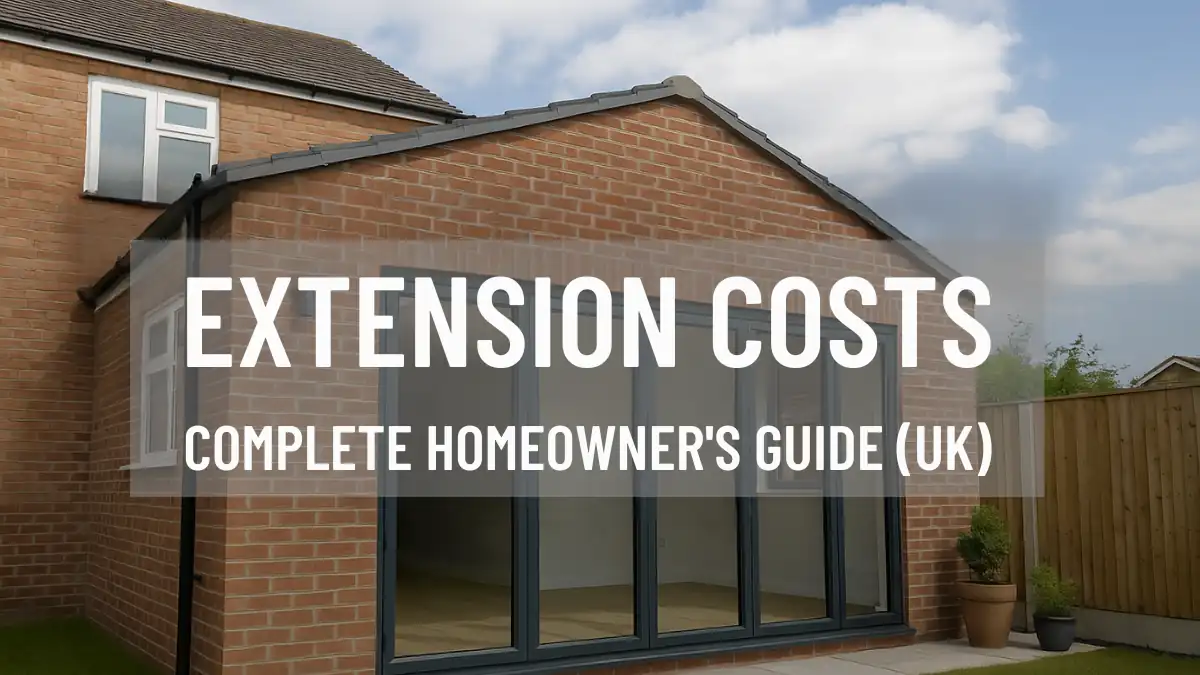Share this post:
🎥 Watch: Extension Costs UK 2025- 4 Tips on What You Need to Budget for Your Home Extension
Prefer to watch instead of read? Here’s our quick 3-minute guide on Extension Costs 👇Wondering how much your extension will actually cost?
Get clear, UK-specific price ranges, m² rates, and the hidden extras most homeowners miss.
Home Extensions • UK Costs & Local Council Quirks
Extension Costs — Complete UK Guide to Prices, m² Rates, Fees & Budgeting
At-a-glance: Typical UK single-storey extension build costs sit around £1,900–£3,200+ per m²; two-storey around £1,700–£2,800 per m² (upper floors slightly cheaper per m²). Add 10–15% contingency, plus design, surveys, planning/building-control fees, utilities and VAT where applicable. London & inner South-East often run +10–20%.
- Kitchen / high-spec fit-outs increase totals substantially.
- Groundworks, drainage and structure drive early costs.
- Local rules (planning, highways, heritage) can add time & fees.
How much do extensions cost in the UK?
The honest answer: it depends on area, ground conditions, structure and specification. For a realistic planning figure in 2025:
- Single-storey (general living space): £1,900–£3,200+ per m²
- Two-storey: £1,700–£2,800 per m² (upper floor cheaper per m² as roof/groundworks are shared)
- Kitchen or utility fit-outs: allow £8,000–£35,000+ for units, worktops, appliances and M&E on top of shell costs, depending on brand & spec
- London / inner South-East uplift: typically +10–20%
Typical m² rates by specification
Use these guide bands to sanity-check quotes and set an initial budget.
| Spec Level | Single-Storey (per m²) | Two-Storey (per m²) | Includes |
|---|---|---|---|
| Basic | £1,900–£2,300 | £1,700–£2,100 | Standard materials, basic glazing, simpler roof forms, painted finish |
| Standard | £2,300–£2,800 | £2,100–£2,500 | Better glazing/doors, decent finishes, typical electrics/heating |
| High-spec | £2,800–£3,200+ | £2,300–£2,800 | Large sliders/rooflights, higher insulation & airtightness, premium finishes |
Worked example budgets
1) 18 m² single-storey rear extension (standard spec)
- Build cost @ £2,500/m²: ~£45,000
- Kitchen & appliances (mid-range): £14,000–£22,000
- Professional & approvals (see below): £3,000–£7,000+
- Contingency (10–15% of build): £4,500–£6,750
- Indicative total: £66,000–£80,000+
2) 28 m² L-shaped wrap/side-return (mixed spec, steels)
- Build cost @ £2,700/m²: ~£75,600
- Glazing package (large slider + rooflights): £8,000–£18,000
- Kitchen upgrade allowance: £18,000–£35,000+
- Fees & approvals: £5,000–£9,000+
- Contingency (12%): ~£9,000
- Indicative total: £116,000–£146,000+
What does an “extension cost” include?
Most build quotes cover the new shell and connection into the house. Expect line items for:
- Groundworks & foundations (including trench, raft or piled solutions)
- Drainage (new runs, diversions, manhole moves)
- Structure (masonry/timber frame, steels/goalposts for openings)
- Roof (warm flat roof, pitched tiles, rooflights)
- First/second fix (carpentry, plumbing, electrics, heating)
- Insulation & airtightness, plaster, skirtings, decoration
- External doors/windows, basic patio make-good
Often not included
- Kitchen, utility, wardrobes, premium flooring
- Landscaping, fences, deep drainage connection fees
- Boiler upgrades, underfloor manifolds beyond allowance
- Professional fees (design, structural), surveys, approvals
Professional fees, surveys & approvals
- Measured survey & drawings (planning + building regs packs): typically £1,200–£3,500+ depending on scope and complexity. See Planning Permission Drawings.
- Structural calculations: £450–£2,000+ depending on number/size of steels and foundations. See Structural Calculations — When Do You Need Them?.
- Planning application (when required): fee typically £258 for householder in England (plus portal service charge) — check the Planning Portal for current fees.
- Lawful Development Certificate (PD proof): recommended; fee similar to householder in many cases.
- Building Control: plan check + inspections; £700–£1,400+ depending on authority and size. See Building Control Inspections – What to Expect.
- Party Wall (if applicable): allow £1,000–£3,000+.
- Utilities: water/sewer build-over consents, electric/gas diversions as needed.
Not sure if you need full planning? Start here: Planning Permission (UK): The Complete Homeowner’s Guide and Building Notice vs Full Plans – Which Route is Best?
Regional price factors & council quirks
Materials and labour vary by region. London and parts of the South-East are often 10–20% higher; remote areas may carry extra travel/lead-time costs. Local councils also influence budgets via conditions (materials, archaeology, highways visibility) and information requests.
Ways to reduce costs (without false economies)
- Keep the form simple: rectangles build cheaper than complex L-shapes and valleys.
- Limit steelwork: align openings with supports; consider a goalpost rather than scattered beams.
- Rationalise glazing: one quality slider beats three smaller openings for cost vs impact.
- Value-engineer finishes: mid-range floors and lighting deliver 80% of the look for far less.
- Decide early: late changes inflate prelims and waste materials.
- Competitive tender: issue a detailed spec/pack to 3–4 builders; compare like-for-like.
Not sure if your idea fits Permitted Development?
We’ll check your project against PD rules and let you know if you need a full planning application.
Kitchen, rear & side return extensions
Kitchen-led schemes carry higher services and appliance costs. Side returns in terraces often need steel goalposts and careful drainage planning, and rear boxes can require rooflights to meet daylight standards.
For scope & design pointers see: Kitchen Extensions: Rules & Costs (UK Guide), Rear and Side Extensions — Which Adds More Value?, and House Extensions: Everything You Need to Know.
Two-storey extensions
Because foundations and roof are shared, the additional upper-floor area is cheaper per m² than the ground floor. But stairs, bathrooms, and fire-safety upgrades can offset savings.
- Budget bands: £1,700–£2,800 per m²
- Check structure: tying into existing floors/roof can add steelwork
- Planning nuance: over-looking, roofline and ridge heights matter — review Planning Permission Cost (UK) and your council’s SPD.
FAQs: extension costs
How much does a house extension cost in the UK?
Allow £1,900–£3,200+ per m² single-storey; £1,700–£2,800 per m² two-storey, plus contingency, fees and any kitchen/bathroom fit-outs.
What is the average cost per m² for an extension?
For mainstream specs, plan around £2,300–£2,800 per m² single-storey as a middle-band guide, adjusting for region and complexity.
Are extensions expensive right now — will prices come down?
Material volatility has eased, but labour remains tight in many regions. Prices change slowly; design simply and tender competitively rather than waiting for a big drop.
What does an extension cost include?
Shell, structure, roof, insulation, first/second fix, basic doors/windows and decoration. Not usually premium kitchens, landscaping, utility upgrades or professional/approval fees.
How much does a kitchen extension cost?
Take the m² shell total, then add £8,000–£35,000+ for units, worktops, appliances and M&E depending on brand and layout. See Kitchen Extensions.
Are extension costs zero-rated for VAT?
Most home extensions are standard-rated (20%). Certain energy-saving measures and new-builds have different VAT treatments; take accountant advice early.
How do I budget for unknowns like drainage and foundations?
Add a 10–15% contingency. Commission early trial pits, CCTV drainage checks or a simple soil investigation to reduce risk before tender.
Will a rear or side return extension add value?
Generally yes if it creates better kitchen/dining space and preserves daylight/flow. For a value-focused design, see Rear and Side Extensions.
Who builds extensions — main contractor or trade-managed?
A single main contractor simplifies programme and warranty; trade-managed can be cheaper but needs strong coordination. We can help you tender both routes.
What’s the cheapest type of extension?
A simple rectangular single-storey with a straightforward roof and modest glazing, keeping services where they are. Complexity and premium finishes drive cost.
Ready to move your project forward?
Plans Made Easy can prepare compliant plans, manage submissions, and guide you from idea to approval.
Next steps & useful guides
- Planning Permission (UK): The Complete Homeowner’s Guide
- Planning Permission Cost (UK): Complete Guide for Homeowners
- House Extensions: Everything You Need to Know
- Building Notice vs Full Plans – Which Route is Best?
- Building Control Inspections – What to Expect
- Structural Calculations — When Do You Need Them?
- Kitchen Extensions: Rules, Planning & Costs (UK Guide)
- Planning Permission for a Garage Conversion (UK)
- Rear and Side Extensions — Which Adds More Value?
- Planning Permission Timelines (UK Guide)
- Certificates & Compliance Documents You Must Keep
- Planning Permission Buckinghamshire: Local Rules & Quirks
For national guidance, see the Planning Portal and GOV.UK — Planning permission in England & Wales.

Performance Verified ✅
This page meets PME Optimisation Standards — achieving 95+ Desktop and 85+ Mobile PageSpeed benchmarks. Verified on


